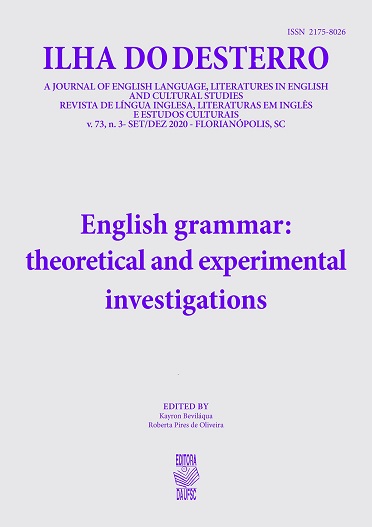Efeitos entonacionais em frases ambíguas em inglês
DOI:
https://doi.org/10.5007/2175-8026.2020v73n3p13Resumo
Este artigo examina o efeito do contorno de entonação em dois tipos de construções escopalmente ambíguas em inglês: configurações com um quantificador universal na posição do sujeito e negação sentencial (por exemplo, Cada cavalo não saltou) e configurações com quantificadores nas posições do sujeito e do objeto ( por exemplo, uma menina viu todos os meninos). Há muita literatura anterior sobre a relação entre a entonação queda-ascensão e a disponibilidade de escopo inverso com configurações de quantificador-negação. O presente estudo tem dois objetivos: (1) examinar se o papel da entonação em facilitar o escopo inverso é restrito a essa configuração, ou se ela se estende também a configurações de quantificador duplo; e (2) examinar se a entonação ascendente elimina totalmente a ambiguidade da frase ou apenas facilita o escopo inverso. Essas questões foram investigadas experimentalmente, por meio de uma tarefa de julgamento de aceitabilidade auditiva, na qual falantes nativos de inglês classificaram a aceitabilidade de sentenças apresentadas auditivamente em contextos correspondentes às leituras de escopo de superfície vs. escopo inverso. Os resultados fornecem evidências de que a entonação queda-ascensão facilita as leituras de escopo inverso das configurações de quantificador-negação em inglês (apoiando os resultados da literatura anterior), mas não as de configurações de quantificador duplo.
Referências
Anderson, C. (2004). The structure and real-time comprehension of quantifier scope ambiguity. (Doctoral dissertation ), Northwestern University Evanston, IL.
Bolinger, D. L. (1958). Intonation and grammar. Language Learning, 8(1‐2), 31-37. doi:10.1111/j.1467-1770.1958.tb01214.x
Bott, O., & Schlotterbeck, F. (2012). Incremental Truth Value Judgments. In B. Stolterfoht & S. Featherston (Eds.), Empirical approaches to linguistic theory. Berlin: Mouton de Gruyter.
Büring, D. (1997a). The great scope inversion conspiracy. Linguistics and Philosophy 20, 175-194.
Büring, D. (1997b). The meaning of topic and focus: the 59th Street Bridge accent. London, UK: Routledge.
Christensen, R. H. B. (2018). ordinal - Regression models for ordinal data. R package version 2018.4-19. http://www.cran.r-project.org/package=ordinal/
Fox, D. (2000). Economy and Semantic Interpretation. Cambridge, Massachusetts: MIT press.
Frey, W. (1993). Syntaktische Bedingungen für die semantische Repräsentation:Über Bindung, implizite Argumente und Skopus. Berlin: Akademie Verlag
Ionin, T., & Luchkina, T. (2015). The relationship between quantifier scope and information structure in Russian: an experimental perspective. Paper presented at the XPrag 2015, Chicago, IL.
Ionin, T., & Luchkina, T. (2017). The one kitten who was stroked by every girl: revisiting scope and scrambling in Russian. In C. Halpert, H. Kotek, & C. van Urk (Eds.), A pesky set: Papers for David Pesetsky. Cambridge, MA: MIT Working Papers in Linguistics.
Ionin, T., & Luchkina, T. (2018). Focus on Russian scope: An experimental investigation of the relationship between quantifier scope, prosody, and information structure. Linguistic Inquiry, 49(4), 741-779.
Ionin, T., & Luchkina, T. (2019). Scope, syntax and prosody in Russian as a second or heritage language. In J. Camacho & M. Cabrera (Eds.), Exploring interfaces: Lexicon, syntax, semantics and sound. Cambridge, UK: Cambridge University Press.
Jackendoff, R. (1972). Semantic interpretation in generative grammar Cambridge, MA: MIT Press
Jacobs, J. (1982). Syntax und Semantik der Negation in Deutschen. Munich, Germany Wilhelm Fink Verlag
Jacobs, J. (1983). Fokus un Skalen: Zur Syntax und Semantik der Gradpartikeln im Deutschen Tübingen, Germany: Max Niemeyer Verlag
Jacobs, J. (1984). Funktionale Sazperspektiven und Illokutionssemantik. Linguistische Berichte, 91, 25-58.
Krifka, M. (1998). Scope inversion under the rise-fall contour in German. Linguistic Inquiry, 29, 75-112
Ladd, D. R. J. (1980). The structure of intonational meaning: Evidence from English.: Indiana University Press.
Lee, W. R. (1955). English intonation: A new approach. Lingua, 5, 345-371. doi:https://doi.org/10.1016/0024-3841(55)90028-0
Lenth, R. (2018). Emmeans: Estimated marginal means, aka least-squares means. R Package, Version 1(2).
Liberman, M., & Sag, I. (1974). Prosodic form and discourse function. In Proceedings of CLS 10 (pp. 416-427). Chicago: Chicago Linguistic Society.
May, R. (1977). The Grammar of Quantification. Cambridge, Massachusetts.
Musolino, J., Crain, S., & Thornton, R. (2000). Navigating negative quantificational space. In Linguistics (Vol. 38, pp. 1-32).
Musolino, J., & Lidz, J. (2006). Why children aren't universally successful with quantification. Linguistics, 44(4), 817-852. doi:10.1515/LING.2006.026
Scontras, G., Polinsky, M., Tsai, C.-Y. E., & Mai, K. (2017). Cross-linguistic scope ambiguity: When two systems meet. Glossa 2(1), 36.31-28.
Syrett, K., Simon, G., & Nisula, K. (2014a). Prosodic disambiguation of scopally ambiguous quantificational sentences in a discourse context. Journal of Linguistics, 50(2), 453-493. doi:10.1017/S0022226714000012
Syrett, K., Simon, G., & Nisula, K. (2014b). Prosodic disambiguation of scopallyambiguous sentence. In NELS 43 Proceedings.
Tunstall, S. (1998). The interpretation of quantifiers: Semantics and processing. (Doctoral Dissertation ), University of Massachusetts at Amherst,
Ward, G., & Hirschberg, J. (1985). Implicating uncertainty: The pragmatics of fall-rise intonation. Language, 61(4), 747-776. doi:10.2307/414489
Downloads
Publicado
Edição
Seção
Licença
Copyright (c) 2020 Mien-Jen Wu, Tania Ionin

Este trabalho está licenciado sob uma licença Creative Commons Attribution 4.0 International License.
A revista Ilha do Desterro publica artigos e resenhas inéditos, referentes as áreas de Inglês, Literaturas em Língua Inglesa e Estudos Culturais. Publica volumes mistos e/ou temáticos, com artigos e resenhas em inglês e português.
Autores mantém os direitos autorais e concedem à revista o direito de primeira publicação, com o trabalho simultaneamente licenciado sob a Licença Creative Commons Attribution que permite o compartilhamento do trabalho com reconhecimento da autoria e publicação inicial nesta revista.

This work is licensed under a Creative Commons Attribution 4.0 International License.



